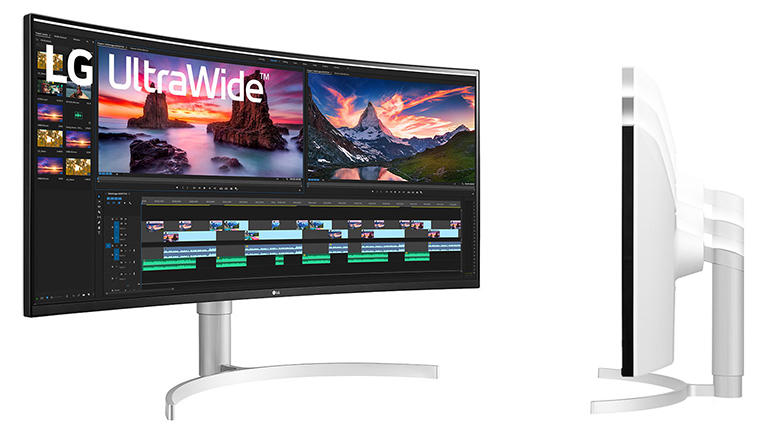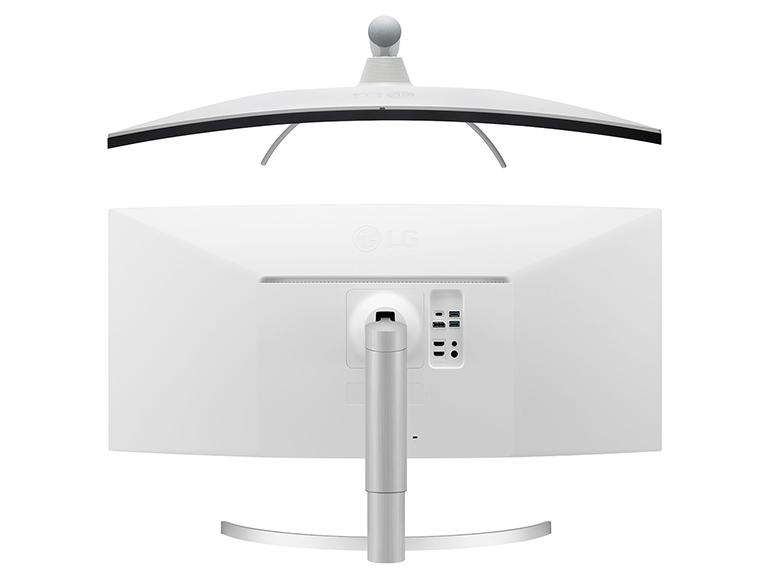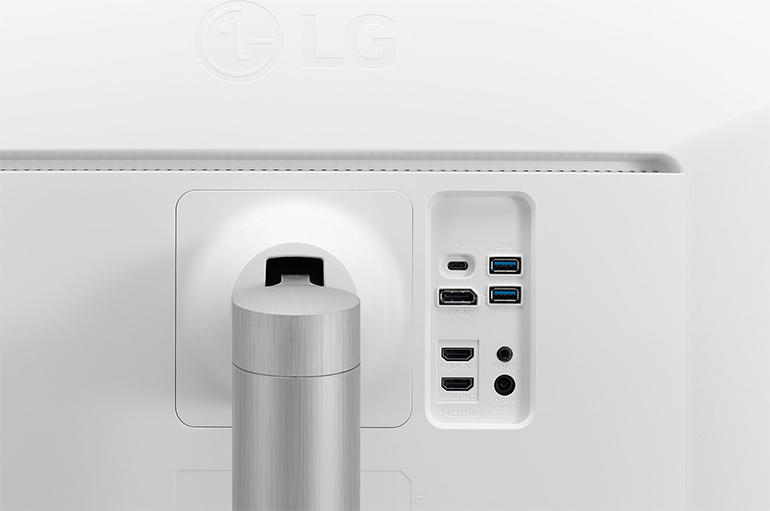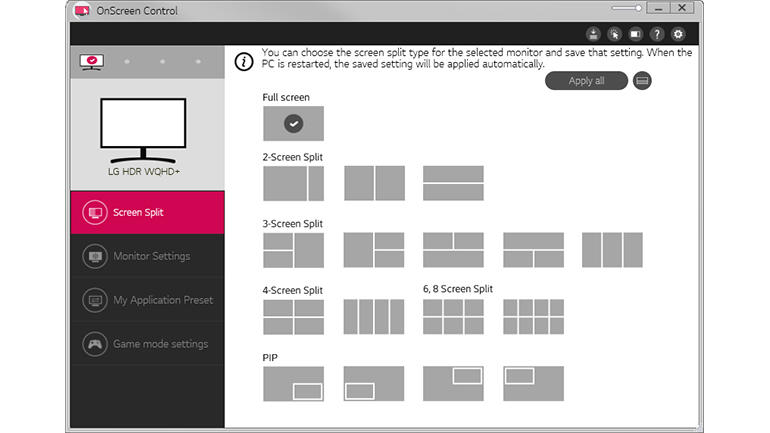A large (>27-inch) monitor is essential for many users in the financial, scientific and creative sectors, and can also prove extremely useful for knowledge workers with the budget and desk space to accommodate one. If you’re looking for a monitor that can cover all these bases, as well as handle any after-hours gaming you might be doing, LG’s curved 38-inch UltraWide 38WN95C-W is an excellent choice. There’s a premium price to pay for all this goodness, though: $1,599.99 in the US.
For that you get QHD+ (3840 x 1600) resolution, good colour gamut and HDR support, wide viewing angles and a fast refresh rate, plus Thunderbolt 3 support and a decent set of display options including Picture-by-Picture (PbP) and Picture-in-Picture (PiP), all encased in a lightweight chassis.
So, is it worth the money?

The 38-inch LG UltraWide 38WN95C-W delivers 3840-by-1600 resolution in a well-specified Nano IPS panel, mounted on a tilt, swivel and height-adjustable stand. The monitor and stand together weigh 8.32kg (18.3lbs).
Images: LGDesign
The LG UltraWide 38WN95C-W comes in a very large box, from which the 38-inch monitor is surprisingly easy to extract and set up. The screen itself weighs just 6.45kg, or 8.32kg when mounted on its stand, which has curved aluminium feet and a plastic-clad vertical section that’s height-adjustable between 583.7mm and 473.7mm (110mm). The monitor also tilts and swivels on its stand.
The screen surround is black, but the back — along with the separate power brick (80W typ/210W max) and bundled cables — is white, and plastic, so take care not to manipulate this monitor with grubby fingers!
A 38-inch curved display panel is naturally going to dominate proceedings, but there’s little in the way of bezels to disturb your view. There’s no built-in webcam, and the top bezel, like the sides, is only a few millimetres thick. The bottom bezel, with the LG logo in the centre, measures about 15mm. There’s an ambient light sensor for automatic brightness adjustment in the centre of the top edge, which is good, although that’s exactly where I placed my external webcam (Logitech’s Brio 4K Pro), which obscured it.
The underside has a small illuminated joystick that controls the on-screen display (OSD), flanked by a pair of downward-firing 5W speakers.


The 38-inch screen has a gentle curve, while the back panel is clad in white plastic. The separate 210W AC adapter and bundled cables also come in matching white.
Images: LGFeatures
The heart of any monitor is its display panel, which in this case is a curved 38-inch Nano IPS that supports 98% of the DCI-P3 colour gamut and is DisplayHDR 600 certified. It has a QHD+ resolution of 3840 by 1600 pixels (21:9, 109ppi), 450 nits brightness and viewing angles of 178˚ in the horizontal and vertical planes.
The Nano IPS panel’s contrast ratio is 1000:1, which is less than the 3000:1 typical of VA panels (the main alternative technology for large displays). However, it has a fast 144Hz refresh rate and 1ms pixel response time, which makes it suitable for video work and after-hours gaming. As well as the high maximum refresh rate, gamers will appreciate the 38WN95C-W’s support for AMD FreeSync and Nvidia G-Sync — Adaptive-Sync technologies that dynamically match the monitor’s refresh rate to the graphics card’s frame rate to avoid tearing and other video artifacts.
Another plus point is the fact that you won’t see your face or surroundings reflected in the screen, as LG’s panel benefits from an effective anti-glare treatment.
At the back, on a small inset panel next to the stand attachment, are the connections: two HDMI, one DisplayPort, one USB-C/Thunderbolt 3, two USB-A downstream ports and a 3.5mm headphone jack.


Connections: 2x HDMI, DisplayPort, USB-C/Thunderbolt 3, 2x USB-A downstream, 3.5mm headphone jack, power input.
Image: LGThunderbolt 3 support with power delivery means you can use up to 94W of the 210W AC adapter’s power to charge your laptop, over the same cable connection that delivers the laptop’s video signal and enables the monitor’s two downstream USB-A ports.
Performance & user experience
Monitor size alone doesn’t make for a satisfying user experience, but if it comes with a high-quality panel such as the 38-inch Nano IPS in the 38WN95C-W, then big really is beautiful. QHD+ resolution, high and uniform brightness, wide colour gamut and a fast refresh rate all make for excellent image quality, and I was able to work comfortably with three side-by-side windows open on-screen — an operational mode that significantly boosts productivity. Adobe Photoshop, an app I use daily, was a pleasure to use on such a large, high-quality canvas.
Although there’s a lot of plastic in the chassis, the monitor feels solid enough on the desk, and the tilt, swivel and height adjustment mechanisms make it easy to position the screen just where you want it.
SEE: Hiring Kit: Computer Hardware Engineer (TechRepublic Premium)
The OSD is accessed by pressing the small joystick beneath the central LG logo. A circular menu gives access to Settings, Game Mode, Input and Power Off selections. Under Settings, the headings are Quick Settings (Brightness, Auto Brightness, Contrast, Volume, Color Temp), Input (Input List, Aspect Ratio, PBP), Picture (Picture Mode, Picture Adjust, Game Adjust, Color Adjust, Picture Reset) and General (Language, Smart Energy Saving, Power LED, Automatic Standby, DisplayPort Version, HDMI Compatibility Mode, Local Dimming, Variable Backlight, Buzzer, OSD Lock and Deep Sleep Mode).


Screen splitting options in the OnScreen Control utility.
Image: Charles McLellan / ZDNetPicture-in-Picture (PiP) and multiple Picture-by-Picture (PbP) modes are configured via a free utility that you’ll need to download. This OnScreen Control utility also lets you adjust monitor settings, create presets for applications and specify game mode settings.
There are a lot of options, but the OSD and OnScreen Control utility make it pretty straightforward to plug in two computers and display their output side-by-side, for example, or quickly switch the monitor into gaming mode when the day’s work is done, or generally tweak the panel’s output until it’s exactly how you like it.
Conclusions
This is an excellent wide-screen monitor with few drawbacks in terms of features and performance, but there’s no getting around the fact that it’s expensive at $1,599.99. For a similar price, you can get the even larger 48.8-inch Philips 499P9H, for example, although its VA panel can’t match the LG 38WN95C-W’s refresh rate and response time, and is therefore less suitable for video work and gaming. If you can manage with a slower refresh rate and response time (60Hz, 5ms), less expansive colour (99% sRGB), lower brightness (300 nits) and no Thunderbolt 3, the more affordable $899.99 LG UltraWide 38WN75C-B may fit the bill better for knowledge workers.
RECENT AND RELATED CONTENT
HP E27d G4 Advanced Docking Monitor review: A versatile and well-connected 27-inch display
Philips 498P9 Brilliance review: Two high-performance QHD displays in one SuperWide 32:9 monitor
High Dynamic Range: The quest for greater image realism
Read more reviews























